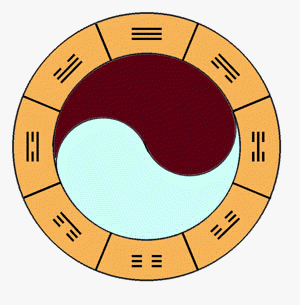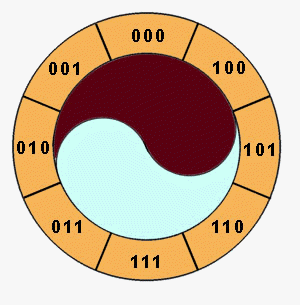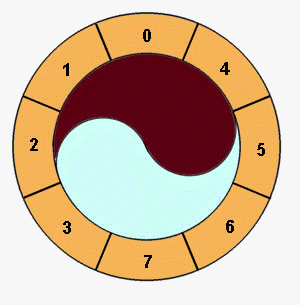|
Part II. "Book of Changes" -
code of the Universe?!.
The previous part of article about
Chinese "Book of Changes" in electronic variant was already published
when the author has acquainted with F.Kapra's book "Dao of physics" where obvious similarity of ancient east philosophies to views of
advanced modern physics is analyzed. In this
connection the opportunity to add "bare" mathematical analysis of the first
part by some reasons has appeared...
* * *
As it was already mentioned in the
first part of the given work, Chinese "Book of Changes" was not simply a "fortunetelling board"
but represented original symbolical quintessence of all
philosophy of Ancient China. The basic idea of this philosophy consists in that
all
phenomena in the universe have dynamic character and the world is filled with
ceaseless metamorphoses and transformations of all real.
"Changes is a book which cannot
be avoided. It Dao changes always - Transformations, movement without one minute of rest,
Proceeding through six emptiness, Rising and rolling without steady law. Firm
and pliable replace each other in one. They cannot be contained in any rule,
only changes operate here" (from Dao's books).
Thus any changes, any alterations are
considered here not as result of action of any forces but as immanent
to all things bent for change.
Peculiarity and originality of such viewpoint of east philosophy were long
interpreted only as certain
"exotic", as smart logic construction far from the real world. But in second
half of XX century such science apparently far from " simple philosophizing "
as the physics suddenly began to come to similar conclusions.
"Dynamic character of east
philosophy is represented to us by one of its major features. East
mystics interpret the Universe as an indissoluble net which webs have not static but dynamic character. This space net is
endowed with life,
it incessantly moves, grows and changes. Finally, the modern physics also
has come to recognition of the world as an original net of
mutual relation and, similarly to east mysticism, postulates internal dynamism
of this net. With dynamic aspect of a matter we face in the quantum
theory describing a dual nature of subnuclear particles having
simultaneously properties of particles and of waves, and in even greater degree - in the relativity theory in which...
it is supposed that the matter can
not exist outside of movement. Hence it is possible to explain properties of
subnuclear particles only in context of dynamic picture of the world that
is in terms of transferences, interactions and transformations" (hereinafter:
citations from F.Kapra, "Dao of physics").
"The quantum theory has found
out that particles are not isolated grains of matter but probabilistic models-webs in indissoluble space net. The
relativity theory has inhaled life in these abstract patterns, having thrown light on their dynamic essence.
It has shown that the matter
can not exist outside of movement and of formation. Particles of subnuclear
world are active not only because they very quickly move; they are processes in
themselves!"
But the affinity of positions of
ancient Chinese views and of modern physics is considerably deeper rather than
"simple coincidence" of main principle.
Say, if the physics for evident representation and for reflection of gist of own principles has got
into the way using
mathematical expressions then according to viewpoint of ancient Chinese all real around of us arises due to known models of realization of changes and
is reflected in them by means of various combinations of lines inside threegrams and hexagrams. But in the first part of the given work it was shown, that in Chinese tradition the
disposition of threegrams and hexagrams is regulated by quite precise and unequivocal
mathematical laws!!!
F.Kapra marks that "the maximal manifestation of similarity of east philosophy views and of modern science is
observed in the theory of S-matrix. S-matrix is a set of
probabilities for all possible reactions with participation of adrons. S-matrix has received such name due to that circumstance that all set
of
possible adron's
reactions can be represented as an infinite cells sequence which in mathematics
refers to as a matrix... One of the major innovations of the theory of
S-matrix consists in that it transfers accents from objects to events;
thus subject of its interest is not particles but reactions between
them. Such displacement of accents follows from positions of
quantum theory and of relativity theory".
But "Book of Changes " also examines not objects but events (i.e. changes). And that is reaction in
S-matrix, in "Book of changes" it is possible event, and
appropriate hexagram is some "code" of the given event. Thus, "Book of Changes "
is original
analogue of S-matrix!..
And this analogy is not limited
only to accent on events but traced on a lot of parameters.
"...theory which units
quantum theory with relativity theory should refuse an exact site of
separate particles... Theory of S-matrix solves this problem by means of indicating
of
exact values only for pulses of particles and of holding back about that site of
space in which there is an appropriate reaction".
But "Book of Changes"
is accented not on concrete situation (initial or final) but only on change
tendency of this situation too that is similar just to pulse of
particle ...
In theory S-matrix and in its development - theory of bootstrap (there is also
such one) - each particle accepts the most active participation in existence of
other particles. Each particle helps to derivate other particles which, in turn,
derivate it. That is all set of particles is interconnected and mutually
dependent.
But according to "Book of Changes" in each situation there is each another, each event ("change") contains
elements of all other events too...
Thus it appears that "Book
of Changes" is the same S-matrix, only ultimate and two-measured. But also it is
six-level
(you see it is constructed on hexagrams - figures with
six elements).
"In "I tszin" [i.e. in "Book of Changes"]
threegrams and hexagrams represent those Dao patterns which are derivated by dynamic alternation
In' and Jan in various situations, both in space and in people's life. These situations
are ones
of infinite course and modification. All things in this world are subject to
variability and fluidity. The same is typical and for their symbolical images -
threegrams and hexagrams. The latter constantly stay in a condition of transformation and
formation: one
figure flows in another, continuous lines cave in and broken off half-and-half,
and two fragments of broken line aspire to be pulled together and to accrete
together with each other. "I tszin" with its doctrine about dynamic patterns
which is produced by
changes and transformations is the closest analogy of east thinking and
the theory of S-matrix. Both these systems of views pay prime attention to
processes but not to objects. In S-matrix theory processes are particles reactions underlying all
phenomena of adrons world. In "I tszin" processes have the name of "changes" and are considered as the
notion which is necessary for description and explanation of all natural
phenomena".
F.Kapra pays attention some more to one
amazing analogy between S-matrixes and "Book of Changes":
"In S-matrix theory the notion of reaction channel has more fundamental value than
notion of
particle. It is determined as the set of quantum numbers which is inherent to
various adrons combinations, and frequently - and to separate adrons. What combination will pass through this or that channel
- it is determined by probability and depends first of all on available amount of
energy ".
"Probability of
reaction in case of two adrons collision depends on amount of energy participating in collision... However
for some values of energy stock the probability of reaction grows rather
sharply; for such values reaction will occur much more often than for all others".
"Changes in adrons world derivate structures and symmetric paterns which can be
symbolically represented as channels of reactions. The physics is not inclined
to attach fundamental importance neither to these structures nor their symmetry,
perceiving them as logic consequence of dynamic nature of
particles from their tendency to transformations and changes".
"In "I tszin" we also deal with generations of changes - special structures,
threegrams and hexagrams
which, as well as channels of particles, represent symbolical images of
possible directions of changes. If channels of reaction are filled
with current of energy, then a stream of "changes" run between lines which form hexagrams..."
It is possible to illustrate this
process as follows: throwing bones, the subscriber (i.e. guessing by "Book
of Changes") for full maintenance of conditions should think about a problem (or
about situation) i.e. should meditate, speaking in other words. Thus, meditating the
subscriber directs his energy to matrix of "Books of Changes" and causes the
certain resonance with some variant of events. In case of resonance
growth of energy
provides "choice" of the most probable variant of events development. Analogy
with S-matrix is practically full...
And moreover. That till now was
considered as "lack" of the theory of S-matrix turns around to its advantage, namely:
dependence of S-matrix structure on consciousness! In
philosophy of "Book of Changes" importance of a role of subscriber consciousness not only is taken into account, but also is one of
basic theses. In the given case the consciousness is that additional energy
source which provides a resonance of appropriate "change" (i.e. of
reaction channel, accoding to the theory of S-matrix).
Further. In
S-matrix theory there are some main principles, limiting opportunities of construction
of S-matrix elements. In particular, according to one of these principles: "outcome
of this or that reaction can be predicted only in terms of probabilities, that
is the sum of probabilities of all possible outcomes - including that
case when interactions between particles do not occur at all - should be
equaled to unity".
But in Chinese "Book of Changes"
possible variants of events development are considered just in terms of probability. It is obvious that the sum of probabilities
of various variants of real life also is equaled to unity. It is including case
of loss of dies during hexagram construction.
If we shall examine "pure" variant of dies throwing then naturally the probability of construction
of concrete hexagram will be equaled 1/64. But if we shall assume that process of
meditation (reflection about situation) transfers to matrix of "Book of Changes" a certain energy, changing distribution of this energy between various
variants, then (according to
methodology of "Books of Changes") probabilities of loss of various hexagrams
will have to change, as though "redistributing"
probability of construction for the benefit of that hexagram which corresponds to "resonant channel of reaction" (i.e. to the
most probable variant of events development). In this case the sum of probabilities
of all hexagrams,
according to specified principle of S-matrix (and according to simple logic), also
should remain to equal unity.
Other principle which limits
opportunities of construction of S-matrix elements "says that
probabilities of reactions (and consequently elements of S-matrix) do not
depend on arrangement of experimental equipment in space and in time,
on its spatial orientation and on condition of observer movement".
Some analogy with this
principle also can be found out in "Book of Changes". As it was specified
in the first part of the given article, numbers of hexagrams form "even-odd" pairs on a basis of "principle of return perusal".
Since hexagram is "one-dimensional" object (there is only one axis "top-bottom")
the change of "observer location" can be expressed only in change
of direction of hexagram perusal relatively to this "dimension": either from the top downward or from below - upwards.
The fact of formation of hexagrams pairs during this change of "orientation"
just will reflect the fact of "changes"
probability independence from "observer position". (Though
this principle in "Book of Changes" is not strictly kept: in spite of all "paired
relationship" however hexagrams turn out different...)
So, the hexagrams table of
"Book of Changes" and principles of its construction find out rather
strong similarity to properties of S-matrix describing fundamental processes
of microcosm. Similar concurrence on set of parameters can not be absolutely
casual... If we take into account interrelation of microcosm with processes of macrocosm
we can tell that "Book of Changes " is not simply "a board for guessing " but a certain
symbolical display of "code of the Universe".
And the problem about sources of "Book of Changes" rises with an extraordinary acuteness...
From whence many thousand years back ancient Chinese have received knowledge to which the modern newest
science steal up only now?..
It is a riddle of riddles!!!
|










